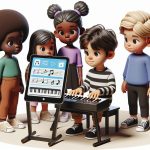Choosing the best keyboard for a 5-year-old can be a delightful yet challenging adventure. It's about finding a balance between fun and educational, ensuring they're engaged and learning at the same time. With the right keyboard, your little one can embark on a musical journey that boosts their creativity and fine motor skills.
In a world filled with options, it's essential to pick a keyboard that's not only age-appropriate but also durable and easy to use. Whether they're just exploring sounds or ready to follow simple melodies, there's a perfect keyboard out there for every budding musician. Let's dive into finding that ideal instrument that'll make their eyes sparkle with excitement and curiosity.
Things to Consider When Choosing a Keyboard
When venturing into the world of music with a child, selecting the right keyboard becomes a pivotal decision. It’s not just about picking the first keyboard one sees. There are specific aspects that cater to the unique needs of a 5-year-old, ensuring the musical journey is both enjoyable and educational.
Size Matters
For little fingers, the size of the keyboard and its keys are essential. A standard keyboard may be overwhelming, with its 88 keys. Instead, look for a model that offers a smaller range, such as 49 to 61 keys. These sizes are more manageable, making it easier for children to explore and learn.
Weighted vs. Unweighted Keys
The touch of the keys plays a significant role in developing motor skills and an ear for music.
- Weighted keys mimic the response of traditional pianos, where more force needs to be applied. This can be beneficial for children to get a real feel of playing an instrument, though it may be challenging for younger kids.
- Unweighted keys, on the other hand, are lighter and easier for small hands to press. They're ideal for beginners, especially young children who are just getting acquainted with a keyboard.
Selecting the right type of key can make the learning process more accessible and more enjoyable for a child.
Durability and Portability
Kids will be kids, meaning anything they use needs to withstand a bit of rough handling. A keyboard that's durable, with a robust build, is a must. It doesn’t just stop at durability.
A portable keyboard is advantageous for families on the move. Whether it’s a visit to grandma’s or a vacation, being able to easily transport the musical instrument allows the child to practice and play, regardless of the location.
Educational Features
While the main aim is to introduce music, incorporating an educational aspect can enhance the learning experience.
- Built-in Lessons: Some keyboards come equipped with pre-programmed lessons tailored for beginners.
- Light-up Keys: Keyboards that feature light-up keys can guide children, showing them which notes to play.
- Sound Variety: Offering a range of sounds and rhythms can ignite a child’s creativity and keep them engaged for longer periods.
Age-Appropriate Features to Look For

When searching for the best keyboard for a 5-year-old, it's crucial to identify age-appropriate features that not only make learning fun but also foster musical growth. Parents and guardians should focus on simple user interfaces and educational tools that cater specifically to young beginners.
Keyboards designed for children often include colorful, easy-to-press buttons and knobs that are intuitive for little hands to navigate. These features can significantly reduce the frustration that young learners might experience when trying to select different sounds or songs. Moreover, keyboards with large, clearly labeled keys can help children in recognizing notes and their corresponding places on the keyboard more easily.
Educational Features
One of the most beneficial aspects of modern keyboards for young learners is the built-in educational content. Look for models that offer:
- Pre-recorded songs that kids can play along with, helping to develop a sense of rhythm.
- Light-up keys to guide finger placement, making it easier for children to learn notes and chords.
- Lesson modes that divide songs into manageable sections, allowing kids to focus on mastering each part before moving on.
These features not only keep the learning process engaging but also provide a structured path for musical development.
Sound Variety
Children are naturally curious and tend to have fluctuating interests. Keyboards that offer a wide variety of sounds can captivate their attention for longer periods. Instruments that include sound effects, different instrument voices, and rhythms, allow children to explore various musical genres and styles. This variety not only enriches their musical experience but also encourages creativity and experimentation.
Safety and Durability
Safety is paramount when it comes to choosing a keyboard for a child. Opt for models that are certified non-toxic and don't have small detachable parts that could be a choking hazard. Furthermore, keyboards that are built to withstand the occasional drop or spill are more likely to endure the energetic activities of a 5-year-old.
Durability does not mean compromising on portability. Lightweight and compact designs ensure that children can easily carry their keyboards around, making music accessible whether they're at home, at a friend's house, or on a family holiday.
Durability and Safety Considerations

When selecting the best keyboard for a 5-year-old, durability and safety should never be overlooked. Young children are known for their boundless energy and curiosity, which can sometimes lead to rough handling of toys and instruments. Therefore, choosing a keyboard that can withstand the occasional drop, bump, or spill is crucial. Manufacturers often highlight the durability of their products, but it's always wise to check the materials used in construction. Keyboards made with heavy-duty plastic and those that have rounded edges tend to offer greater resilience against the rigors of daily use by energetic children.
Safety is another paramount consideration. Children's products, including musical instruments, must adhere to stringent safety standards to ensure they're non-toxic and free from small parts that could pose a choking hazard. Always look for keyboards that are certified by reputable safety standards organizations such as the Consumer Product Safety Commission (CPSC) in the United States.
In addition to external safety features, it's essential to consider the volume control on a child's keyboard. Young ears are more sensitive to loud sounds, so a keyboard with adjustable volume settings or one that caps at a decibel level safe for children can prevent accidental hearing damage. Some models come equipped with a headphone jack, allowing for quieter practice sessions and helping to protect the child’s hearing.
Portability plays a role in both durability and safety. A lightweight keyboard that's easy for a child to carry minimizes the risk of dropping and injury. Many portable models come with handles or are designed to be compact enough for small arms to grasp comfortably. This feature not only makes the keyboard more resilient but also encourages children to take their music wherever they go, fostering a sense of independence.
A few points parents and guardians should consider include:
- Materials: Opt for keyboards made from durable, non-toxic materials.
- Design: Look for designs that incorporate rounded edges and sturdy construction.
- Certifications: Check for safety certifications from recognized authorities.
- Volume Control: Ensure the keyboard has adjustable volume or headphone options to protect hearing.
- Portability: Consider the weight and handle design for safe and easy transportation.
Educational Benefits of Different Keyboards

Selecting the right keyboard for a 5-year-old is about more than just durability and safety. The educational benefits tied to various types of keyboards are essential in fostering a child's musical journey. Keyboards, often the first musical instrument a child encounters, lay the foundation for a lifelong appreciation of music. They can significantly influence a child's cognitive development, fine motor skills, and understanding of music theory.
Cognitive Development
Research shows that early exposure to music can enhance a child's cognitive development, improving areas such as memory, attention, and problem-solving skills. Keyboards designed with interactive features, such as built-in lessons or games, can make learning more engaging for young minds. These interactive keyboards often incorporate colorful lights, sounds, or screen displays that guide children through lessons, making the learning experience both fun and educational.
Fine Motor Skills
Playing the keyboard requires coordination between the hands and eyes, promoting the development of fine motor skills. For young children, keyboards with mini keys are more suitable as they are easier to play with small hands. Some keyboards are specifically designed to encourage the correct hand positioning and finger movement, which is crucial in developing proper playing technique from an early age.
Understanding of Music Theory
Grasping the basics of music theory at a young age can be a game-changer for a child's musical journey. Keyboards that include features such as note labels or follow-along songs help introduce children to musical notes, scales, and rhythms. This early introduction can demystify complex music concepts, making them more accessible and less intimidating for young learners.
Emotional and Social Benefits
Beyond the cognitive and motor skills benefits, playing the keyboard can have a profound effect on a child's emotional and social development. Music creation offers an outlet for expression, helping children convey their emotions and improve their mood. Additionally, if they attend music classes or online forums, they'll likely interact with peers and instructors, enhancing their social skills.
Types of Keyboards and Their Benefits
Different keyboards offer unique benefits tailored to various learning styles and objectives. Here's a quick overview:
| Type of Keyboard | Benefit |
|---|---|
| Interactive Keyboards | Engages with interactive lessons, improving cognitive development |
| Mini-Key Keyboards | Easier for small hands, enhancing fine motor skills |
| Light-Up Keyboards | Visual aids help in learning notes and chords |
Conclusion
Choosing the right keyboard for a 5-year-old is more than just picking out a toy; it's about fostering a love for music while supporting their developmental milestones. With the array of options available, from interactive to light-up keyboards, there's a perfect match for every young learner's needs. Remember, the best keyboard is one that not only fits your child's learning style but also grows with them, offering both fun and educational value. So, take these insights, weigh the features against your child's interests and abilities, and you'll surely strike the right chord in their musical journey.
Harlan Kilstein began playing piano during covid with no piano background at all. He taught himself how to play learning what to do and what not to do.
Today he's an advanced intermediate player and can help you grow in your skills because he learned all this on his own.








